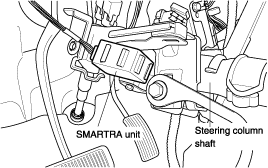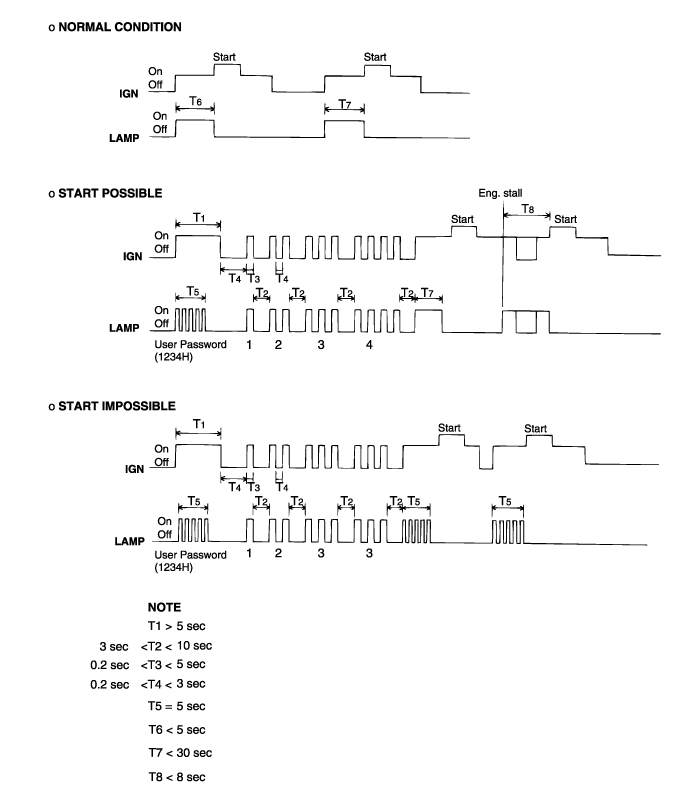
The immobilizer system consists of a passive challenge-response (mutual authentication) transponder inside the key head and the SMARTRA (SMARt TRansponder Antenna) unit.
The SMARTRA unit contains an integrated inductive antenna and electronics around the lock assembly. The SMARTRA communicates to the ECM (Engine Control Module) via a dedicated communications line.
Since the vehicle engine management system is able to control engine mobilization, it is the most suitable unit to control the SMARTRA.

The vehicle immobilizer system consists of the ECM, the SMARTRA and ignition keys with built-in transponder.
The ECM carries out the check of ignition key by special encryption algorithm, which runs in the transponder and in the ECM in parallel. Only if the results are equal, the engine can be started. The data of all transponder, which are valid for the vehicle, are stored in the ECM.
The ECM and the SMARTRA communicate by dedicated line. During this communication of ECM and SMARTRA the K line of ECM cannot be used for communication. The ECM controls the communication either to SMARTRA or to other devices (e.g. service tester) on K line by switching of a multiplexer and specific communication procedures. The multiplexer is a part of ECM hardware.The SMARTRA carries out the communication with the built-in transponder of the ignition key. This wireless communication runs by RF (Radio frequency of 125 kHz). The SMARTRA is mounted at the ignition lock close to the antenna coil for RF transmission and receiving. The RF signal from the transponder received by the antenna coil is converted into messages for serial communication by the SMARTRA device. And the received messages from the ECM are converted into the RF signal, which is transmitted, to the transponder by antenna.
The SMARTRA does not carry out the check of validity of transponder or the calculation of encryption algorithm. This device is only an advanced interface, which converts the RF data flow of transponder into serial communication to ECM and vice versa.
The transponder is of Hitag2 type with advanced encryption algorithm. During the key teaching procedure the transponder will be programmed with vehicle specific data. The vehicle specific data are written into the transponder memory. The write procedure is unique; therefore the content of transponder can never be modified or changed. The data are a string of 9 bytes defined by vehicle manufacturer. The transponder memory is split into two strings called authenticator and key password.
After this programming the transponder memory is locked and the data cannot be read or changed respectively. The transponder status changes from "virgin" to "learnt".
Additionally every transponder includes a unique IDE (Identifier number) of 32 bit. Unique means that the IDE of all transponder is different from each other. The IDE is programmed by the transponder manufacturer and is a read-only value.
The authenticator and the key password are not transferred from ECM to transponder or vice versa. Only the results from the encryption algorithm are transferred. It is almost impossible to calculate the vehicle specific data from the encryption result.
For teaching of keys and special purposes the ECM is connected to the tester device. This can be the manufacturer’s service tester, which is in use at service station. The protocol of communication is the K line of ECM.
Key teaching must be done after replacing a defective ECM or when providing additional keys to the vehicle owner.
The procedure starts with an ECM request for vehicle specific data from the tester. The "virgin" ECM stores the vehicle specific data and the key teaching can be started. The "learnt" ECM compares the vehicle specific data from the tester with the stored data. If the data are correct, the teaching can procede.
If incorrect vehicle specific data have been sent to the ECM three times, the ECM will reject the request of key teaching for one hour. This time cannot be reduced by disconnecting the battery or any other manipulation. After reconnecting the battery, the timer starts again for one hour.
The key teaching is done by ignition on with the key and additional tester commands. The ECM stores the relevant data in the EEPROM and in the transponder. Then the ECM runs the authentication required for confirmation of the teaching process. The successful programming is then confirmed by a message to the tester.
If the key is already known to the ECM from a previous teaching, the authentication will be accepted and the EEPROM data are updated. There is no changed transponder content (this is impossible for a learnt transponder).
The attempt to repeatedly teach a key, which has been taught already during the same teaching cycle, is recognized by the ECM. This rejects the key and a message is sent to the tester.
The ECM rejects invalid keys, which are presented for teaching. A message is sent to the tester. The key can be invalid due to faults in the transponder or other reasons, which result from unsuccessful programming of data. If the ECM detects different authenticators of a transponder and an ECM, the key is considered to be invalid.
The maximum number of taught keys is 4
If an error occurs during the Immobilizer Service Menu, the ECM status remains unchanged and a specific fault code is stored.
If the ECM status and the key status do not match for teaching of keys, the tester procedure will be stopped and a specific fault code will be stored at ECM.
The user password for limp home is taught at the service station. The owner of the vehicle can select a number with four digits.
User password teaching is only accepted by a "learnt" ECM. Before first teaching of user password to an ECM, the status of the password is "virgin". No limp home function is possible.
The teaching is started by ignition on, with a valid key and sending the user password by tester. After successful teaching, the status of the user password changes from "virgin" to "learnt".
The learnt user password can also be changed. This can be done if the user password status is "learnt" and the tester sends authorization of access, either the old user password or the vehicle specific data. After correct authorization, the ECM requests the new user password. The status remains "learnt" and the new user password will be valid for the next limp home mode.
If incorrect user passwords or wrong vehicle specific data have been sent to the ECM three times, the ECM will reject the request to change the password for one hour. This time cannot be reduced by disconnecting the battery or any other actions. After reconnecting the battery, the timer starts again for one hour.
The status is stored in the EEPROM. In case of incorrect or no plausible data from this circuit, the ECM cannot check the status and the ECM sends 00.
The password has been taught successfully to the ECM.
This is the status at the end of the ECM production line before delivery to the final customer.
After a certain number of incorrect inputs, the ECM is locked for one hour and no inputs are accepted during this time.
This status is set if, for example, the ECM is in neutral status.

LIMP HOME BY TESTER
If the ECM detects the fault of the SMARTRA or transponder, the ECM will allow limp home function of the immobilizer. Limp home is only possible if the user password (4 digits) has been given to the ECM before. This password can be selected by the vehicle owner and is programmed at the service station.
The user password can be sent to the ECM via the special tester menu.
Only if the ECM is in status "learnt" and the user password status is "learnt" and the user password is correct, the ECM will be unlocked for a period of time (30 sec.). The engine can only be started during this time. After the time has elapsed, engine start is not possible.
If the wrong user password is sent, the ECM will reject the request of limp home for one hour. Disconnecting the battery or any other action cannot reduce this time. After econnecting the battery to the ECM, the timer starts again for one hour.
LIMP HOME BY IGNITION KEY
The limp home can be activated also by the ignition key. The user password can be input to the ECM by a special sequence of ignition on/off.
Only if the ECM is in status "learnt" and the user password status is "learnt" and the user password is correct, the ECM will be unlocked for a period of time (30 sec.). The engine can be started during this time. After the time has elapsed, engine start is not possible. After a new password has been input, the timer (30 sec.) will start again.
After ignition off, the ECM is locked if the timer has elapsed 8 seconds. For the next start, the input of the user password is requested again.